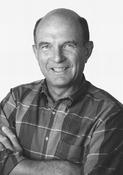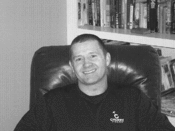|
Press
|
|
By Roy Benson and Declan Connolly
ISBN: 978-07360-8655-4
Binding: Paperback
Pages: Approx. 240
Price: $16.95
Available: March 2011
CHAMPAIGN, IL—The biggest problem with most current exercise programs is that they are not based on a person’s unique body shape, size, physiological response, and, most important, current level of fitness. To get the most out of a program you need to make your effort individualized, and the easiest way to do that is to track your cardiac response to your body’s movement of choice.
According to exercise scientist and distance-running coach Roy Benson, author of the forthcoming Heart Rate Training (Human Kinetics, 2011), individualization must be based on your current fitness level, general ability, and goals. The good news is that modern technology has produced a wide selection of affordable heart rate monitors that provide instant, reliable feedback about your body’s response to your chosen exercise and intensity. Says Benson, “When you understand your heart rate, learn how to measure it, and have a reliable monitor, you are on your way to a scientifically designed exercise program, individualized just for you, that will guarantee results.”
Whether you are a beginner, intermediate, or advanced athlete, Benson believes there is a heart rate monitor with all the bells and whistles you need. And once you find the best way to make a heart rate monitor work for you and learn to apply the principles of exercise physiology in order to get in the best possible shape, you will benefit from training that fits perfectly with your ability, level of fitness, and goals. “Progressing through each of these steps is a cinch when you use a heart rate monitor because it allows you to easily individualize your training,” explains Benson. “The principles are broad, but your response is as narrow as your ability, shape, and goals require.”
In Heart Rate Training, Benson and co-author Declan Connolly take the guesswork out of training and explain how, when, and why heart rate monitors should be incorporated into training and conditioning programs. Their comprehensive guide for endurance athletes explains the merits, factors, and techniques of training with a heart rate monitoring system.
For more information, see Heart Rate Training.

|

|

|
Roy T. Benson, MPE, CFI, is an exercise scientist and distance-running coach. He has run competitively for more than 40 years, and he has coached professionally for 46 years for military, club, university, and high school teams. From 1993 to 2008, his boys’ and girls’ cross country teams at Marist High School in Atlanta, Georgia, won a total of 16 state championships, and his cross country and track runners won 21 individual state titles. Benson is also the owner and president of Running, Ltd., a company that has been operating Nike-sponsored summer camps for both adult and high school runners since 1972.
Benson has been a consultant about heart rate training for both Polar and Nike and has written three books for runners on the subject. He also serves as a special contributor to Running Times magazine and has been a contributing editor for Running Journal magazine. His booklet Precision Running, published by Polar Electro, has sold over 200,000 copies and has been translated into seven languages. Sales of Coach Benson’s Secret Workouts book have reached more than 7,000. Benson lives on Amelia Island, Florida.
Declan Connolly, FACSM, CSCS, is a professor and exercise physiologist at the University of Vermont where he is also director of the Human Performance Laboratory. He consults to numerous sport organizations, including the National Hockey League, the National Football League, U.S. Rowing, and U.S. Skiing and has served as a consultant to the International Olympic Committee on several occasions. In addition to more than 300 publications in scientific journals, his work is widely quoted in the popular media, including stories in the New York Times, Los Angeles Times, London Times, Runner’s World, Prevention, Health, and Self. His work appears on more than 24,000 Web sites and has been the subject of news stories on Fox, BBC, CBS, and numerous other TV and radio networks.
Connolly is a lifelong exerciser and athlete, boasting several national cycling championships as a boy in his native Ireland. More recently he has turned his focus to triathlon and Ironman competitions. Connolly lives in Burlington, Vermont.
Part I: Foundations
Chapter 1: Monitoring for Maximum Performance
Chapter 2: Evaluating and Customizing Your Zones
Chapter 3: Getting the Most from Your Monitor
Part II: Training
Chapter 4: Targeting Sport-Specific Fitness With Heart Rate
Chapter 5: Increasing Aerobic Endurance
Chapter 6: Raising Anaerobic Threshold
Chapter 7: Boosting Speed and Power
Part III: Programs
Chapter 8: Designing an Effective Training Program
Chapter 9: Walking
Chapter 10: Running
Chapter 11: Cycling
Chapter 12: Swimming
Chapter 13: Triathlon
Chapter 14: Rowing
Chapter 15: Cross Country Skiing
Chapter 16: Team Sports

|
 Roy Benson |

 Declan Connolly |

|
- Explain what a heart rate monitor does.
- Why should heart rate monitors be incorporated into workouts, training, and conditioning programs?
- What do heart rates reveal about training?
- How can athletes determine deficiencies in training and performance?
- How do you create a personalized exercise program, and what factors should be considered?
- What are the four main components of fitness, and why must they be developed in a progressive manner?
- Why do personal training goals and genetics affect responses to heart rate training?
- What are some of the biggest myths about heart rate monitors?
- What is the most effective way to determine maximum heart rate?
- Why is it important to monitor the resting heart rate as well as the target heart rate?
- A Finnish company, Polar Electro, developed the first wireless heart rate monitor in 1977. (The Runner’s Edge)
- Modern time and distance watches can track mileage, pace, and heart rates over the course of a workout or race and use that data in training for a runner’s specific physiology and fitness level. (Running Times magazine)
- The idea that anyone can subtract his or her age from 220 bpm to predict a reliable MHR is a myth. Maximum heart rates are naturally spread across the standard distribution of a bell-shaped curve. There is a wide range from one end of the curve to the other for people of the same age. This distribution means only those right in the middle can reliably predict MHR by using the age-adjusted formulas. Depending on where a person falls on the curve, the MHR may be as high as 36 bpm above or below what the formula predicts. (Heart Rate Training)
- Studies found that on an individual basis, the minimum heart rate during sleep varied about 8 beats per minute. This amount of intrinsic day-to-day variation needs to be considered when changes in heart rate that may occur with changes in training status are interpreted. (Journal of Sports Science and Medicine, 2003).
- Decades of studies indicate that athletes are surprisingly good at distinguishing among training zones by tuning in to their bodies. A 1986 study at the University of Liverpool, for instance, found that instructing runners to run at "somewhat hard" or "hard" efforts was at least as good as heart rate at predicting intensity. More recently, studies conducted by sport scientist Carl Foster, PhD, at the University of Wisconsin-La Crosse have shown that runners can consistently identify their tempo pace with a simple talk test—struggling to speak in full sentences means you’ve passed your threshold. (Runner’s World magazine)
“Roy Benson has more specific coaching experience for every age and competitive level than anyone I know. Combining that practical knowledge with the scientific expertise of Declan Connolly, this book is an unparalleled guide to maximizing your training using a heart rate monitor, providing both the how and why for each element, and putting it all together in an accessible, easy-to-apply package.”
Jonathan Beverly, Editor in Chief, Running Times
"Heart Rate Training offers unparalleled exercises and advice for athletes of every sport, every level, and every age."
Alex Krebs
Eastern Development and Competitions Manager
U.S. Ski and Snowboard Association
“In Heart Rate Training, Benson and Connolly show you how to interpret and apply your heart rate data into a practical science-based training program that provides results.”
Malachy McHugh, PhD
Director of Research
Nicholas Institute of Sports Medicine and Athletic Trauma

|
|
|
|
|

|
 
|